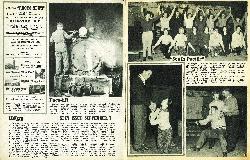2
Our Cover
This charming view of the entrance to Waihirere Domain was taken when the autumn colours were at their best. The picnic ground, eight miles north-west of Gisborne city, is a popular place at any time, but particularly in the summer, when its cool, bush-fringed walks are a delight.
Back Cover. The Colour picture on the back cover of this issue is of the Te Mana o Turanga meeting house at Whakato, Manutuke. Opened in 1883, it was a replacement for the house Te Hau-ti-Turanga, formerly at Orakaiapu Pa, which stood on the riverbank immediately behind the present Post Office at Manutuke. This house was sold in the l860's and is now in the Dominion Museum. The name Whakato means "to plant", and was given to the marae when the Rev.William Williams transferred the mission there in 1841 from Kaupapa where it was originally established in 1839 and later abandoned because of flooding. The name commemorated the planting of the "Rongo pai" or "good word".
Te Mana o Turanga is one of the oldest meeting houses still used. Its carvings tell the story of the Maori from creation to European times, and commemorate such important people as Pawa (Paoa). Kiwa, Pourangahua, Ruawharo & Tupai, Paikea & Ruatapu, Maui, Tutekohe, and Rakai-hikuroa. Paikea came to New Zealand on the back of a whale and is the ancestor of the Ngati-porau.
The figure at the apex of the fascia boards represents Timata, the eponymous ancestor of the Ngati-Timata. The left-hand fascia depicts the separation of Ranginui (the sky father) and Pa-patuanuku (the earth mother) by their offspring, while the right-hand fascia shows Maui fishing up the North Island (Te ika a Maui).



